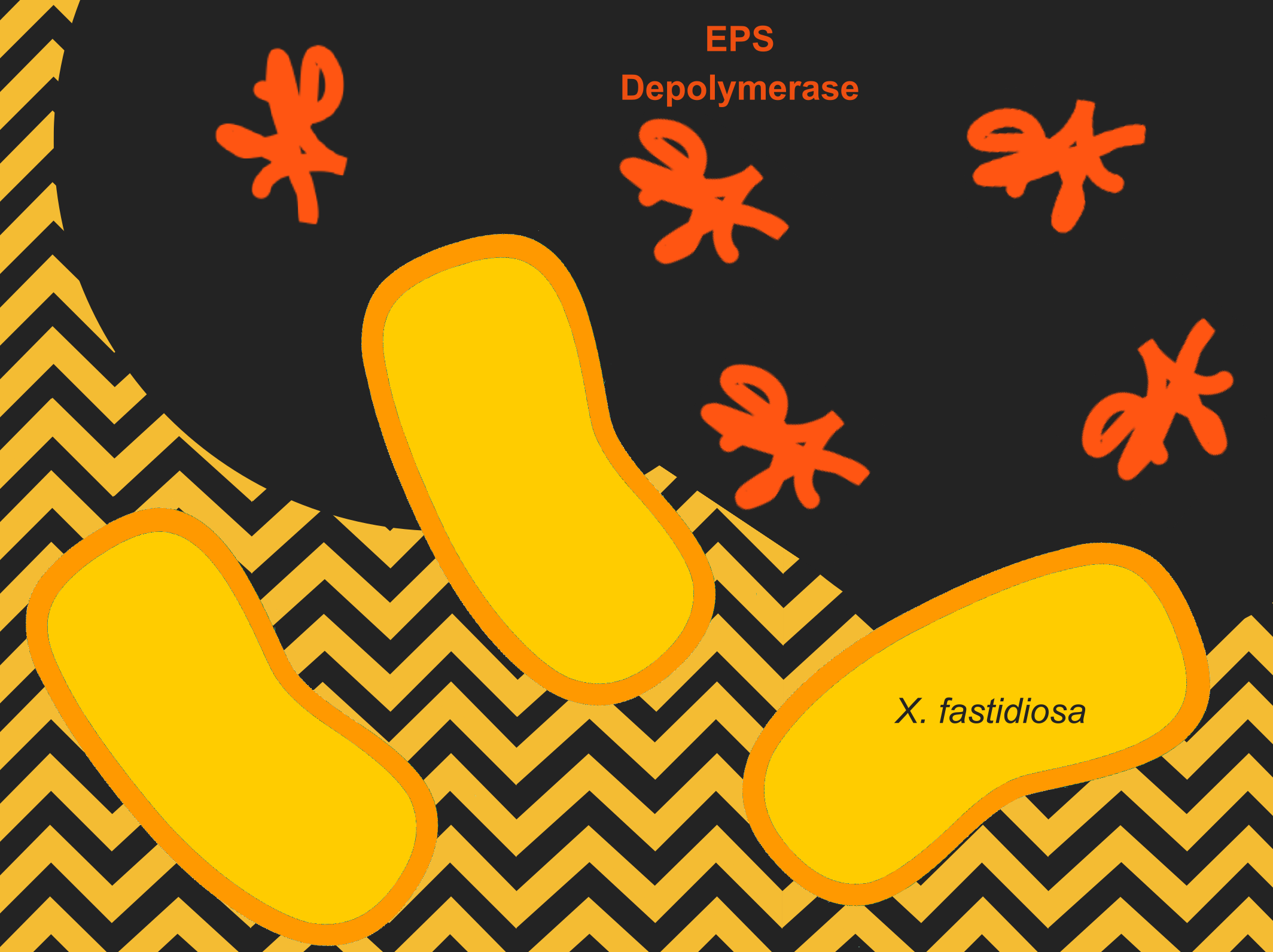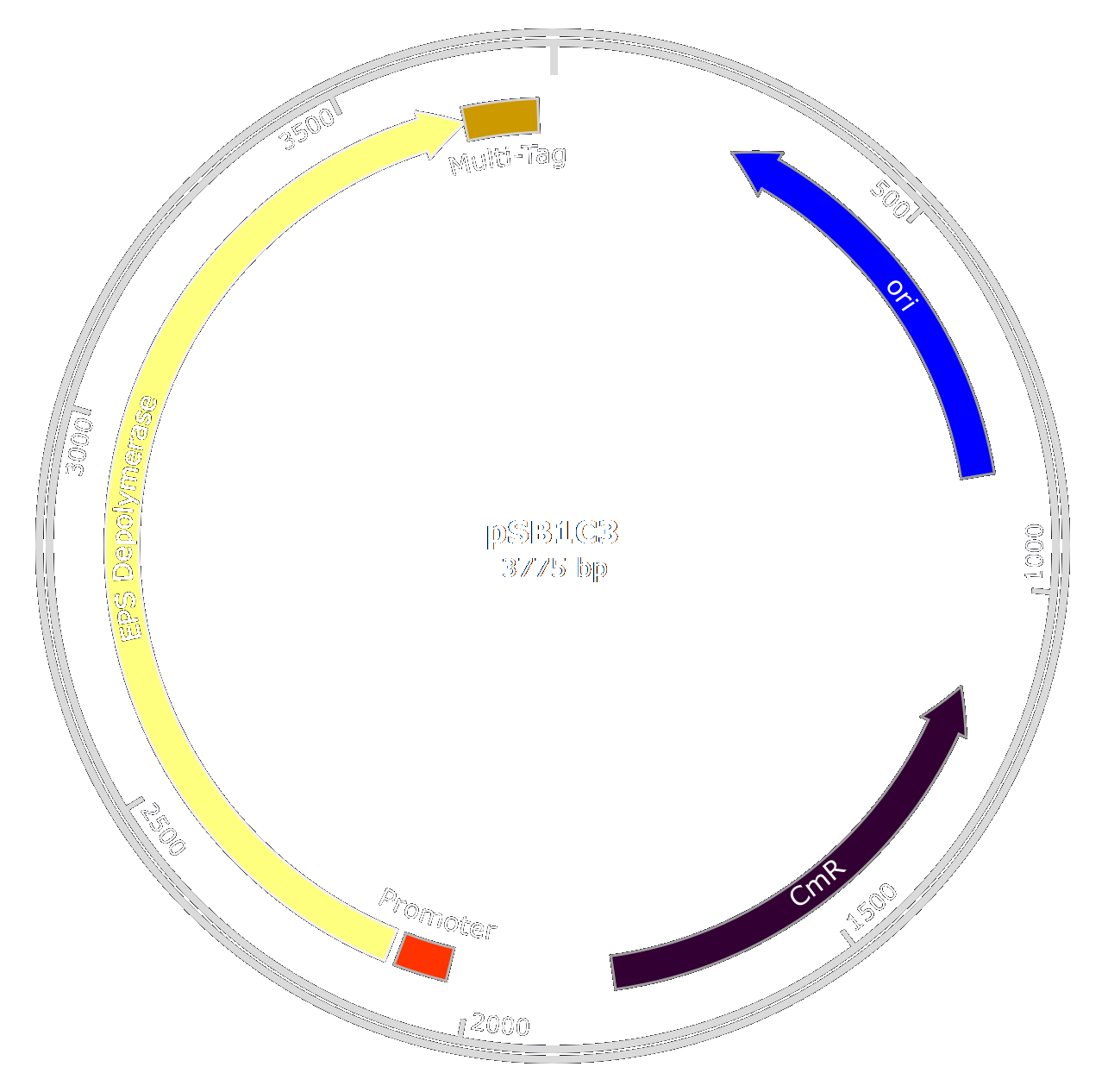| Line 3: | Line 3: | ||
[[File:T--Aix-Marseille--EPSd.png|450px|right|thumb|EPS Depolymerase process to clean the xylem vessel from EPS.]] | [[File:T--Aix-Marseille--EPSd.png|450px|right|thumb|EPS Depolymerase process to clean the xylem vessel from EPS.]] | ||
| − | To fight the problem that is [[Team:Aix-Marseille/Xylella_fastidiosa|''Xylella fastidiosa'']] we | + | To fight the problem that is [[Team:Aix-Marseille/Xylella_fastidiosa|''Xylella fastidiosa'']] we started searching for natural solutions against this bacterium and surely, we found bacteriophages. Many phages have a devious way to infect the bacterium; by cleaving the sugar bond in the biofilm they found more easily their target <ref>Vandenbergh, P. A., Wright, A. M. & Vidaver, A. K. Partial Purification and Characterization of a Polysaccharide Depolymerase Associated with Phage-Infected Erwinia amylovora. Appl. Environ. Microbiol. 49, 994–996 (1985)</ref>. |
As the symptoms observed in plants are the result of water stress resulting from occlusion of xylem vessels by bacterial biofilm and/or accumulation of extracellular polysaccharides we wanted to found a way to free the xylem vessels. The goal of this design isn’t to threat [[Team:Aix-Marseille/Xylella_fastidiosa|''X. fastidiosa'']] or to prevent the infection, but to use a enzyme called EPS-depolymerase <ref>Kim, W. S. & Geider, K. Characterization of a Viral EPS-Depolymerase, a Potential Tool for Control of Fire Blight. Phytopathology 90, 1263–1268 (2000).</ref>. | As the symptoms observed in plants are the result of water stress resulting from occlusion of xylem vessels by bacterial biofilm and/or accumulation of extracellular polysaccharides we wanted to found a way to free the xylem vessels. The goal of this design isn’t to threat [[Team:Aix-Marseille/Xylella_fastidiosa|''X. fastidiosa'']] or to prevent the infection, but to use a enzyme called EPS-depolymerase <ref>Kim, W. S. & Geider, K. Characterization of a Viral EPS-Depolymerase, a Potential Tool for Control of Fire Blight. Phytopathology 90, 1263–1268 (2000).</ref>. | ||
Revision as of 14:32, 10 October 2017
EPS Depolymerase
Contents
To fight the problem that is Xylella fastidiosa we started searching for natural solutions against this bacterium and surely, we found bacteriophages. Many phages have a devious way to infect the bacterium; by cleaving the sugar bond in the biofilm they found more easily their target [1].
As the symptoms observed in plants are the result of water stress resulting from occlusion of xylem vessels by bacterial biofilm and/or accumulation of extracellular polysaccharides we wanted to found a way to free the xylem vessels. The goal of this design isn’t to threat X. fastidiosa or to prevent the infection, but to use a enzyme called EPS-depolymerase [2].
This enzyme has the capacity to hydrolyse polysaccharidic bond of the EPS composing the biofilm, thus it can free the xylem vessels.
EPS Depolymerase design
As we wanted to limit the number of GMOs in our product we wanted a production of the enzyme in E. coli and an efficient purification system.
The original enzyme used by the phage is long and its gene are not made for a production in E. coli. Thus, to produce large quantities of the enzyme, we thought about the optimisation of the enzyme by only taking the fonctionnal part of the original enzyme and we optimize its sequence for a production in E. coli. This lead us to the creation of the EPS-Depolymerase par : [http://parts.igem.org/Part:BBa_K2255006 BBa_K2255006].
As we wanted to purify the EPS Depolymerase for its use in our cure, we also engineer a multi-tag. This tag is composed of a histidine-tag, that bind to Nickel or Cobalt ions and a Strep-tag that bind to streptavidine. Thus we created the biobrick [http://parts.igem.org/Part:BBa_K2255003 BBa_K2255003].
Those biobrick will be fused with the help of [http://parts.igem.org/Assembly_standard_25 Rfc25] restriction site. Finaly, to produce the enzyme in huge amount we decided to add a strong and constitutive promoter in E.coli ([http://parts.igem.org/Part:BBa_K608002 BBa_K608002]).
References
- ↑ Vandenbergh, P. A., Wright, A. M. & Vidaver, A. K. Partial Purification and Characterization of a Polysaccharide Depolymerase Associated with Phage-Infected Erwinia amylovora. Appl. Environ. Microbiol. 49, 994–996 (1985)
- ↑ Kim, W. S. & Geider, K. Characterization of a Viral EPS-Depolymerase, a Potential Tool for Control of Fire Blight. Phytopathology 90, 1263–1268 (2000).



